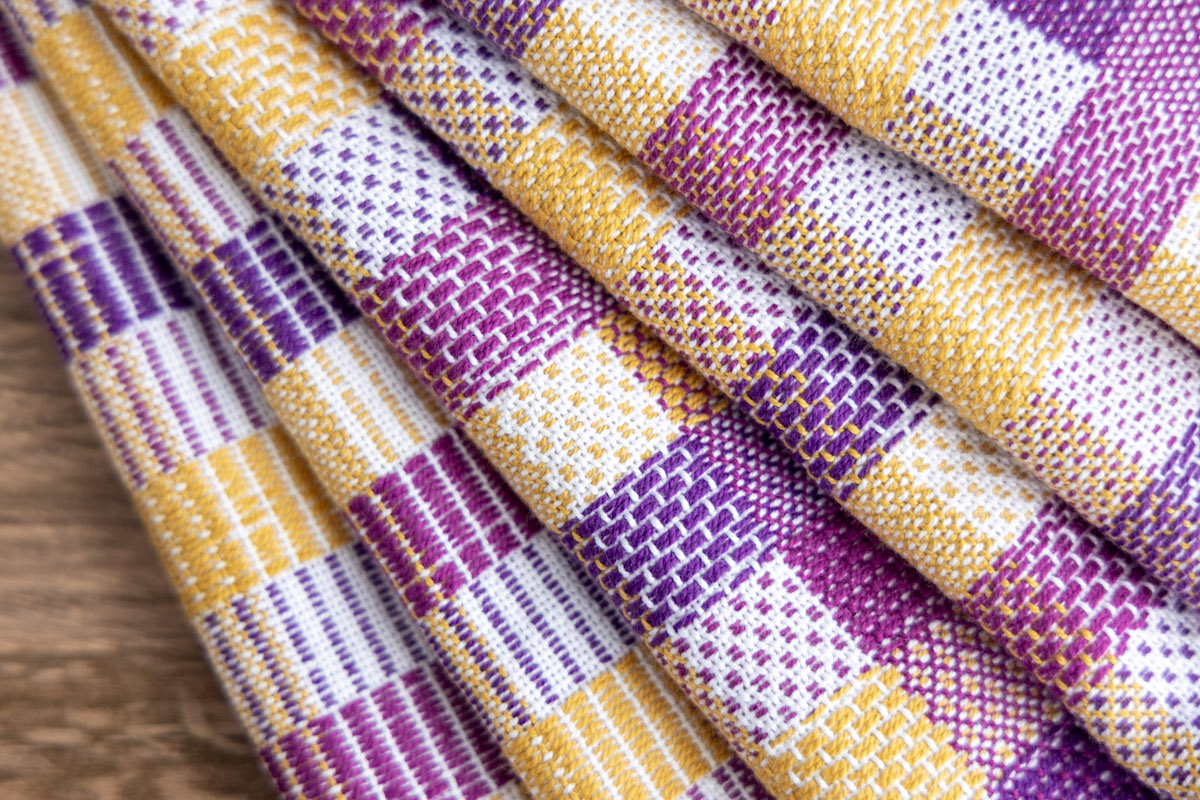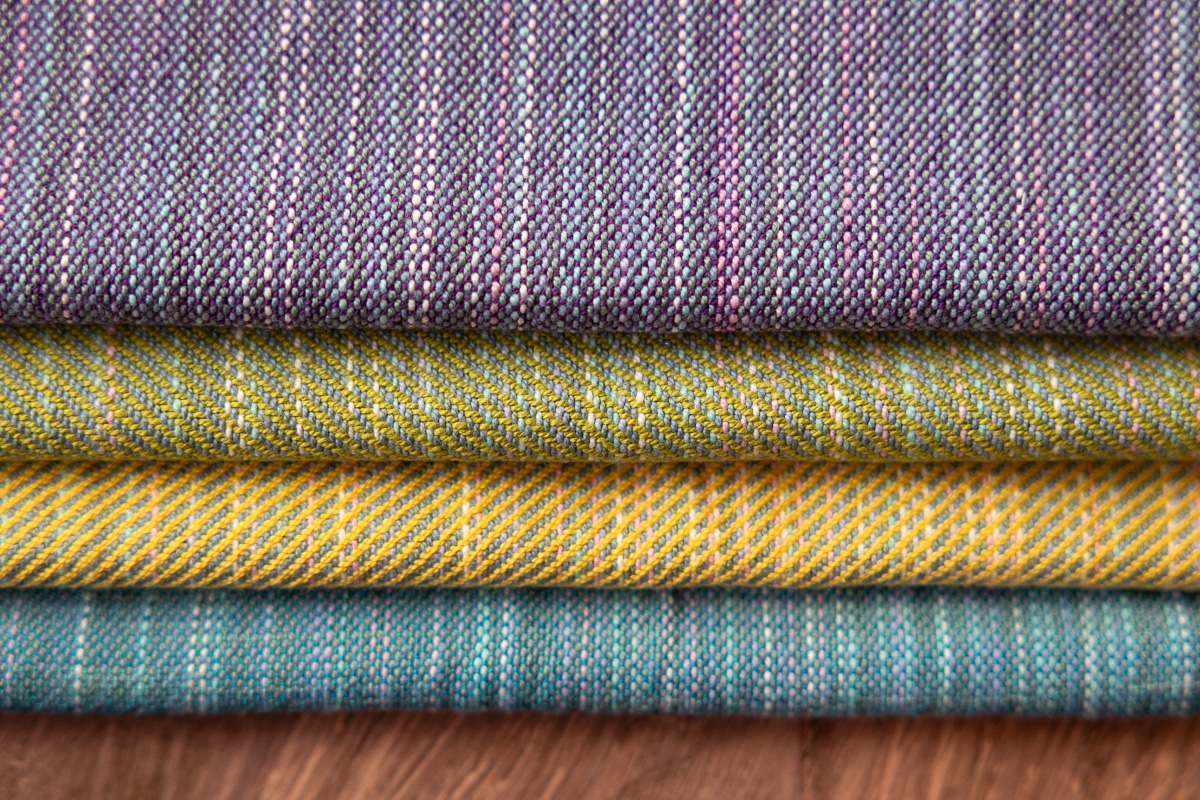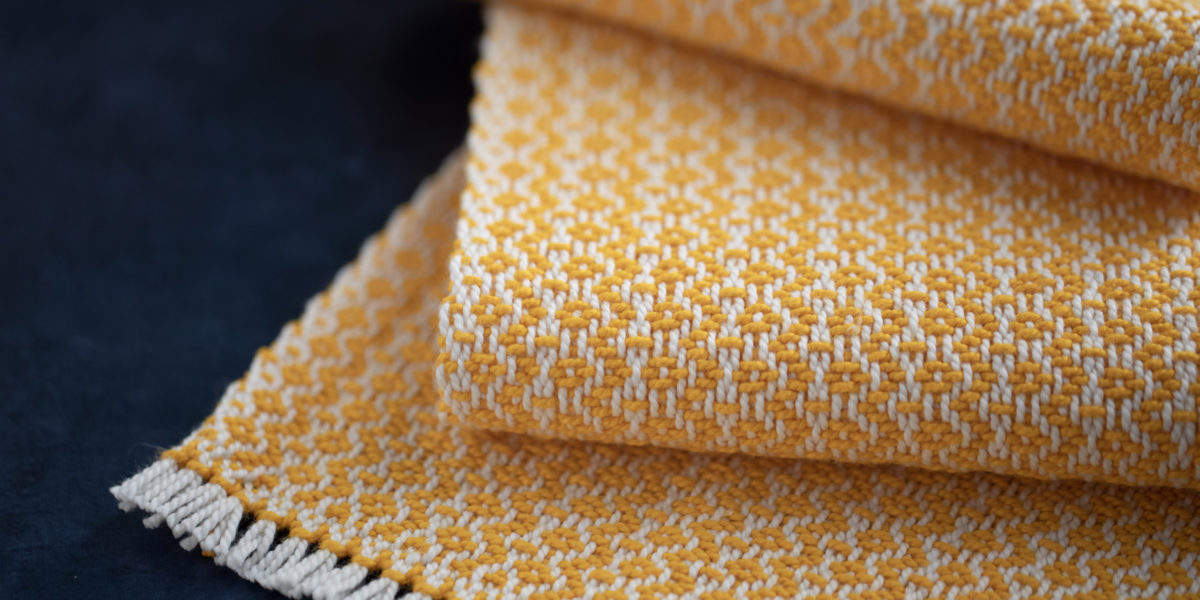Weave Longer Warps to Save Time & Effort This Holiday Season
Handwoven items are some of the most meaningful gifts you can give. The possibilities are endless: scarves, shawls, towels, table runners, pillows, blankets, and more. We also know it is often quicker to weave a throw than to knit one, making last-minute handwoven holiday gifts feel much more attainable. And, one of the greatest advantages of weaving is the ability to put on long warps. A longer warp saves time and effort by allowing you to create multiple projects from one setup. Who doesn’t love that?!

Know Your Loom
Before you dive into making longer warps, it is important to understand that there are limitations. The type of loom, the materials you use, and your own physical comfort all play a role.
Loom Limitations
Rigid heddle looms typically allow 5 to 8 yards of warp, depending on the loom and the material limitations discussed below. (Some rigid heddle looms hold more; 5 to 8 is just an average.) While that may not sound like a long warp, rigid heddle looms take less time to dress, so you can move from one project to the next quickly.
Multi-shaft looms generally hold anywhere from 5 to 50 yards, again depending on the loom and whether it is a table or floor loom. Once you go beyond 15 yards, look to see if sectional warping is an option for your loom; it can help maintain consistent tension with longer warps. Laura Fry offers a detailed course on Sectional Warping that explores both technique and design possibilities with sectional warping.

As you wind on, you will learn your loom’s limits. If the warp begins touching the yarn rolled on the back beam, or winding feels increasingly slow and tight, you may have reached capacity. When in doubt, check with your manufacturer for the recommended maximum length. It is better to know before you begin than to discover halfway through that the warp will not fit.
Material Limitations
The way you separate warp layers on the back beam also affects how much warp length you can manage. Bamboo blinds or wood sticks take up more space, while cardboard sticks or Kraft paper allow you to wind on more warp.
Yarn choice also matters. Large, squishy yarns, such as DK-weight wool in the Minimalist Double Weave blanket, take up much more space than finer options, like 8/2 cotton for the Radiant dish towels.
Your Limitations
Longer warps require more attention to tension and yarn management, which means more time winding on. If a 5-yard warp feels challenging, resist the urge to jump straight to a 12-yard warp. Increase gradually, one warp and one yard at a time. This approach helps your body adjust while also teaching you more about your loom and materials.
Every loom is different, and every weaver is too. Listen to your body and notice how your loom responds.

Why We Love Longer Warps!
There are many advantages to longer warps: saving time, producing multiple projects, sampling, and dummy warps, just to name a few. So, as we move into the holiday season, let’s dive deeper into why you might want to start weaving with longer warps!
Saving Time
Beginner projects such as scarves and table runners are often short, just 1 to 2 yards. They are excellent for practice, but you may quickly find that you spend more time dressing the loom than weaving. A longer warp keeps you weaving at the loom longer. For example, making a 6-yard warp takes only a little more time than a 3-yard warp, but gives you far more weaving time.

We recently published the Shoreline Checks pattern. Designed for rigid heddle weavers, though easily adapted for multi-shaft looms, it allows you to weave two scarves on one warp, keeping you weaving longer!
Multiple Projects, Multiple Gifts
Instead of planning a warp for one scarf, plan for two or three. You can vary the design by changing the treadling: one in a straight draw, another in broken twill, and a third in a plain weave design. The same approach works beautifully for towels by simply changing the weft colours. This gives the weaver something new to weave along the same warp, ensuring you don’t get bored weaving the same thing over and over again.

A perfect example of this is Laura Fry’s Sister Tea Towels, a pattern exclusive to the School of SweetGeorgia. She designed these towels in her Sectional Warping course, showing how just changing the weft colours and treadling can produce towels that are uniquely different, yet still belong together as a beautiful gift set.
Sampling
Sampling is one of the most practical reasons to add length to your warp. Including 20 inches for sampling adds very little to the warp but can save you from disappointment later. Extra length allows you to test colours, adjust your design, and confirm that the fabric turns out just as you have envisioned it!
Sampling at the end of a project can also be rewarding. An extra yard gives you room to experiment with leftover bobbins or new ideas. Finished samples can often become coasters, placemats, or plant mats, small but great last-minute gifts!

In some cases, a sampler (a project made just for sampling ideas) can even become the project itself. The sampler in the Multi-Shaft Weaving Basics course is a wonderful way to explore warping, treadling, and colour. Many School of SweetGeorgia members have turned theirs into table runners, a beautiful touch to add to your table this holiday season!
Dummy Warps
A dummy warp is essentially a ‘stand-in’ warp. You may use one to save expensive yarn from loom waste or when weaving many projects with the same threading, but with different warps.
You wind on the dummy warp, then tie each new project warp to it. This reduces waste, eliminates rethreading projects with the same draft, and speeds up the process. Dummy warps are often longer, so they can be reused many times, saving both time and materials.
When Felicia Lo designed her Sunset and Staccato scarves for the Handpainted Warps course, she used a dummy warp. Both warps were hand-painted, and she wanted to make two scarves from each warp without losing any length to loom waste. If you haven’t tried a dummy warp, this could be the perfect opportunity for you to start. Not to mention, you can weave a scarf for yourself, and share the other!
Final Thoughts
Long warps save time, make multiple projects possible, encourage sampling, and let us enjoy every inch of yarn. They help us spend more time weaving and less time setting up. Most of all, they open the door to exploring more ideas within a single warp.
We hope this inspires you to try weaving longer warps, and discover the possibilities waiting there. And, it may just help you knock a few more gifts off your list this holiday season!

Learn to Weave & Join Our Community
- At the School of SweetGeorgia, we’ve built a vibrant and welcoming community of fibre-loving makers, passionate instructors, and dedicated staff. Whether you’re looking for guidance on a new technique or just need a little creative encouragement, we’re here to support you every step of the way.
- Not yet a member of the School? We invite you to come and see what it is all about! Use the code: EXPLORETHESCHOOL to save 15% on an All-Access monthly membership!
- We welcome you to join us in our SweetGeorgia Community. This is where we share projects that inspire, have fibre-filled conversations, host make-alongs, and participate in a variety of virtual meetings! We discuss all things knitting, crocheting, spinning, weaving, machine knitting, and more!
- Want to stay in the loop? Subscribe to our newsletter! It’s a simple way to stay updated on what’s new at SweetGeorgia and the School of SweetGeorgia, catch up on the latest articles, watch new SweetGeorgia YouTube videos, and be a part of our community without any pressure to post. We value your presence, no matter how you choose to connect with us!
The post Weave Longer Warps to Save Time & Effort This Holiday Season appeared first on SweetGeorgia Yarns.




Comments
Post a Comment